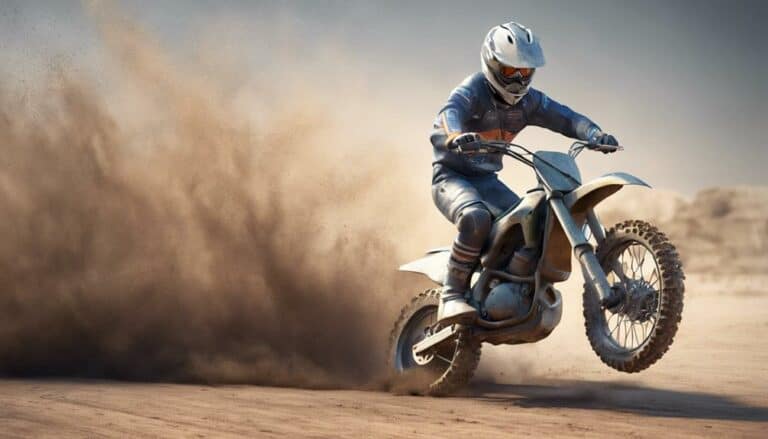If you think your body positioning on a dirt bike is just about comfort, think again. Leaning too far back, incorrect foot placement, not keeping elbows up, failing to shift weight properly, and overlooking head position are common mistakes that could be hindering your control.
These errors may seem minor, but they play a significant role in your overall performance and safety while riding. Learn how these subtle adjustments can make a world of difference in your dirt bike handling and maneuvering.
Key Takeaways
- Leaning too far back compromises control and stability, shift weight slightly forward for better handling.
- Incorrect foot placement affects balance, position balls of feet on footpegs for improved stability.
- Keep elbows up for maneuverability, stability, and reduced fatigue while riding a dirt bike.
- Proper weight shifting is crucial for balance and control, master techniques to navigate turns and obstacles effectively.
Leaning Too Far Back
Leaning too far back on a dirt bike compromises control and stability, particularly during acceleration and braking. When you lean excessively back, you shift your weight away from the front wheel, reducing traction and making it harder to steer. This can result in a loss of control, especially on rough terrain or when maneuvering tight turns. Additionally, leaning too far back puts strain on your lower back, leading to discomfort and potential back injuries.
To maintain better control and stability on your dirt bike, focus on proper body positioning. Instead of leaning too far back, aim for a slight forward lean. This helps distribute your weight more evenly between the front and rear wheels, improving handling and maneuverability. By keeping your weight centered and slightly forward, you'll have better control over your bike, especially when accelerating, braking, or encountering obstacles. Remember, your lower back will thank you for maintaining the correct posture while riding.
Incorrect Foot Placement
Improper foot placement on a dirt bike can greatly impact your weight distribution and balance, affecting control and stability during off-road riding. Placing your feet too far forward on the footpegs can disrupt your center of gravity, making it harder to navigate challenging terrain or sharp turns. Conversely, keeping your feet too close together limits stability and hinders your ability to shift your weight effectively while riding off-road.
To guarantee ideal control and maneuverability, it's essential to position the balls of your feet on the footpegs. This placement allows for better balance and responsiveness when handling the bike. Additionally, adjusting your foot position according to the terrain and riding conditions is key to maintaining stability and maximizing control throughout your off-road adventures.
Not Keeping Elbows Up
Incorrect positioning of your elbows while riding a dirt bike can greatly impact your control and overall performance on challenging terrain. When you fail to keep your elbows up, you risk losing control and stability, hindering your ability to navigate through obstacles effectively. Here are some key points to keep in mind regarding the significance of maintaining your elbows up:
- Improved Maneuverability: Elbows up position allows you to make quick adjustments and maneuvers, enhancing your overall control of the bike.
- Enhanced Stability: Proper elbow positioning helps absorb impacts and maintain stability, especially when riding over rough terrain.
- Reduced Fatigue: Riding with elbows down can lead to arm pump and fatigue, whereas keeping your elbows up can help alleviate these issues.
- Better Balance: Elbows up position enables you to distribute your weight more evenly, contributing to better balance and control while riding.
Failure to Shift Weight Properly
Properly shifting your weight while riding a dirt bike is essential for maintaining control and balance on varying terrains. Failing to shift your weight correctly can lead to a loss of balance and control, making it challenging to steer through turns and obstacles effectively. Incorrect body positioning and weight distribution can cause the bike to veer off course or even tip over, especially when handling rough terrain or bumps. Mastering weight shifting techniques is vital for maintaining stability and maneuvering the bike with precision.
| Common Mistakes in Weight Shifting | Consequences |
|---|---|
| Not leaning in the right direction | Bike veering off course or tipping over |
| Inadequate weight transfer | Difficulty handling rough terrain and bumps |
| Incorrect weight distribution | Challenges in steering through turns and obstacles |
Overlooking Head Position
When riding a dirt bike, overlooking your head position can result in unnecessary strain on your neck and shoulders, impacting your balance and visibility on the track. To guarantee ideal head positioning for better control and safety, consider the following:
- Align Your Head with Your Spine: Keeping your head in line with your spine reduces strain and allows for smoother movements while riding.
- Keep Your Head Up: Avoid the temptation to look down; instead, keep your head up to maintain a clear view of the track ahead and anticipate any obstacles.
- Eyes on the Horizon: Focus your eyes on the horizon to enhance your ability to react swiftly to changes in the terrain or other riders.
- Relax Your Neck: Tensing your neck muscles can lead to fatigue and discomfort. Stay relaxed and adjust your head position as needed to maintain a neutral spine alignment.
Proper head position is essential for maintaining control, preventing injuries, and enhancing your overall dirt bike riding experience.
Conclusion
To sum up, mastering proper body positioning on a dirt bike is essential for control and safety. Avoid leaning too far back, keeping elbows down, incorrect foot placement, and overlooking head position. By addressing these common mistakes, you'll enhance your riding experience and prevent potential injuries.
Remember, just as a well-tuned engine guarantees peak performance, proper body alignment is the key to unleashing your full potential on the track. So, straighten up, rev your engines, and ride on with confidence!

